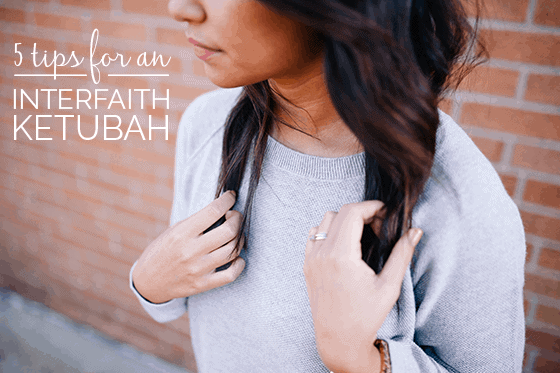The Interfaith Ketubah – My 5 pieces of advice

When I began planning my interfaith wedding in the fall of 2012, finding a ketubah was basically a given. I knew the tradition had deep cultural significance for my Jewish fiancé, and I was excited to participate. After all, signing a ketubah with my husband-to-be felt like a wonderful way for me to get closer to his faith, his culture, and his family. I was all in.
But once we began looking at ketubahs, I had a hard time seeing myself and my values reflected in the traditional ketubah texts and designs. It was from this disconnect that the first real discussions about the future of our interfaith family were born. On the surface, we were simply debating our preferences for our ketubah, but in fact we were laying the groundwork for our shared values and hopes for the future. And as it turned out, there was a lot more middle ground than we had anticipated.
Creating a ketubah together ended up being my favorite part of the wedding planning process. But it wasn’t without its challenges, which is why I would like to leave you with a few tips about the process.
Here are my five pieces of advice if you’re thinking about having an interfaith ketubah at your wedding:
1) Do it. I know that in terms of difficulty, creating an interfaith ketubah ranks somewhere between accommodating your vegan/paleo/gluten-free guest and finding a dress that your conservative Bubbie deems appropriate. But it is so worth the effort. The discussions that we had around our interfaith ketubah were some of the most infuriating, beautiful, deep and challenging conversations we had leading up to the wedding. And we came out of them a closer couple with a solid and communal understanding of the values we wanted in our marriage.
2) Don’t rush it. More than other ketubahs where your Rabbi will often ask that you choose between a couple of pre-approved texts, the interfaith ketubah is a more wily beast. I recommend starting the process 4-6 months before your wedding so that you’ll have plenty of time to find an artist you like, select or write your text, and have it produced.
3) Consider writing your own text. There are countless beautiful interfaith ketubah texts out there (here’s mine), and if you find one that speaks to you, congrats! But don’t pick a pre-written text just because it’s convenient. Many ketubah artists can have your custom text translated into Hebrew for you. Here’s a step-by-step guide for writing your own ketubah text if you’re considering this option!
4) Run your plans by your Rabbi / Officiant. If you’re having a Rabbi officiate your ceremony, be sure to discuss your ketubah plans with him or her. Many Rabbis will give you free reign to write what you please, but others will want to make sure you include a specific idea or phrase.
5) Pick your artwork carefully. If the text of your ketubah is the cake, then the artwork is the icing. Spend some time investigating different artists until you find one whose subject matter and style capture something special about your relationship. Most artists are also happy to create a custom piece of artwork just for you.
I do lots of custom designs, as do many other ketubah artists (The Painted Ketubah and Love by Leya are two of my favorites!)
Each morning when I wake up and each evening when I go to bed, I see our framed interfaith ketubah hanging in our bedroom. I pause to think about the day we signed it together, and the many happy days to come. And I know that every moment we spent on our ketubah was worth it.

Hello!
I'm Adriana Saipe, founder of Ink with Intent. I'm a full-time wedding illustrator who specializes in contemporary ketubahs and unique wedding certificates. Learn more.

Be the first to get special offers, updates from the studio, and more
CONNECT:


